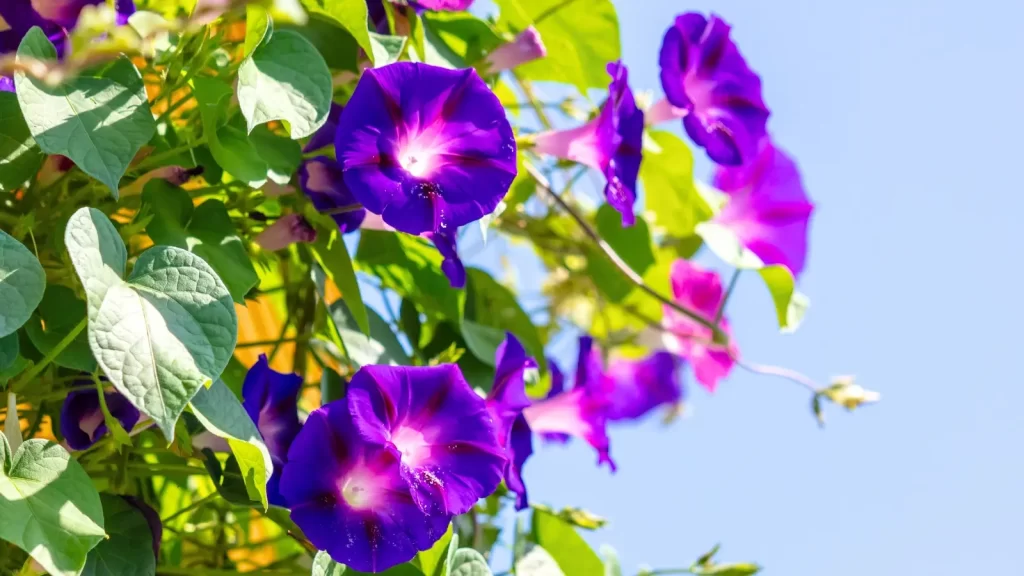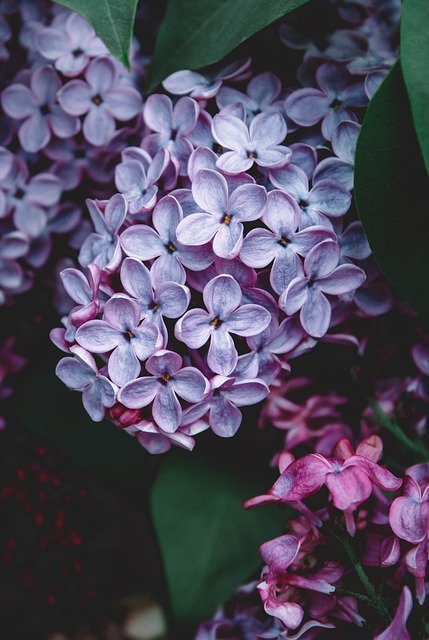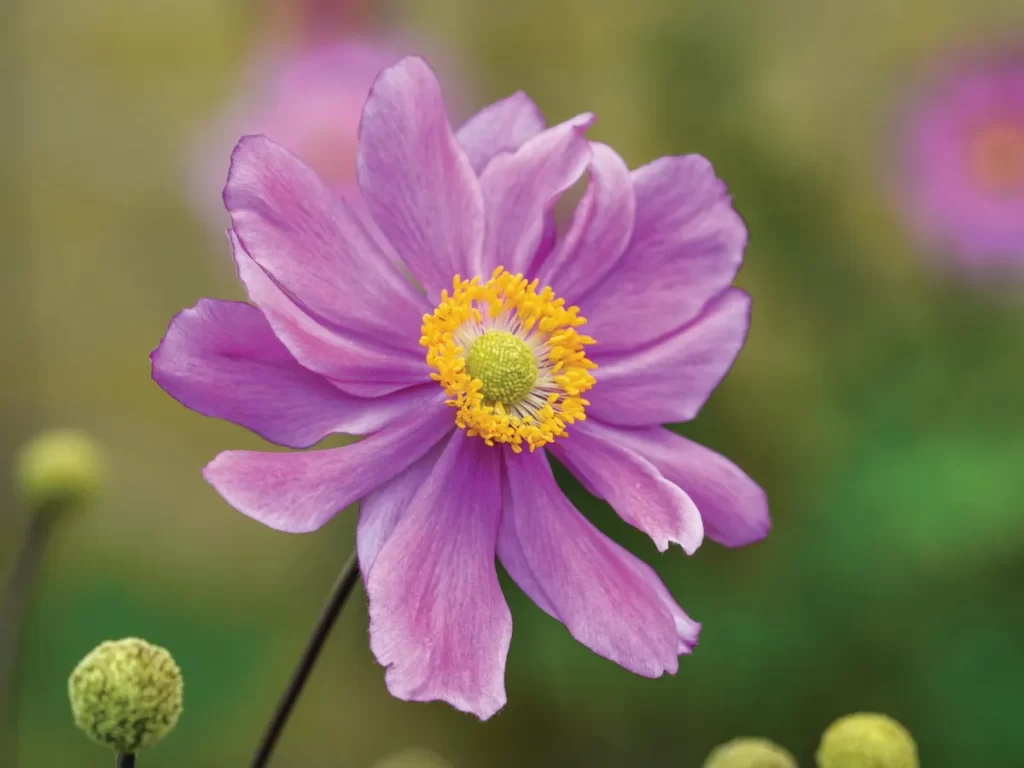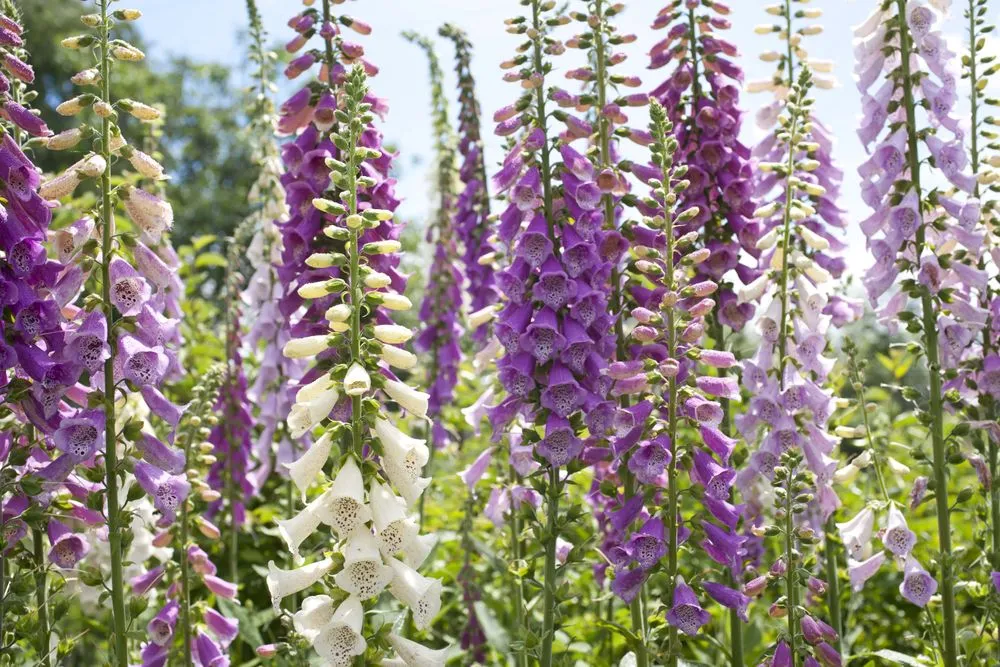Table of Contents
Purple flowers have a unique charm that sets them apart in any garden. Whether you’re aiming to create a serene retreat, attract pollinators, or add a splash of sophistication, these blooms are a perfect choice. Purple, often associated with luxury, creativity, and peace, can transform your garden into a tranquil haven. From the delicate, climbing vines of wisteria to the vibrant, sun-loving petunias, the variety of purple flowers ensures there’s something for every gardener’s taste and skill level.
In this article, we’ve carefully curated a list of 25 stunning purple flowers. Each entry is packed with essential information, including plant type, size, soil and sunlight needs, bloom times, and expert tips to help you grow them successfully. By the end, you’ll be equipped with the knowledge to pick and cultivate these beauties, adding depth, contrast, and charm to your garden.
25 Purple Flowers For Your Garden
Annual Purple Flowers
1. Pansy (Viola tricolor)
- Plant Type: Annual.
- Height/Spread: 6–9 inches tall; spreads 6–12 inches.
- Soil Needs: Moist, well-drained soil rich in organic matter.
- Sunlight Needs: Full sun to partial shade.
- Bloom Time: Fall, winter, and early spring in mild climates.
- Geographic Origin: Europe and western Asia.
- Growing Zones: 6–10 (grown as annual).
- Flower Tip: Deadhead spent blooms to encourage continuous flowering.

2. Petunia (Petunia spp.)
- Plant Type: Annual.
- Height/Spread: 6–18 inches tall; spreads 18–36 inches.
- Soil Needs: Loamy, well-drained soil with a slightly acidic pH.
- Sunlight Needs: Full sun.
- Bloom Time: Spring to frost.
- Geographic Origin: South America.
- Growing Zones: 9–11 (grown as annual).
- Flower Tip: Fertilize biweekly to keep blooms vibrant and healthy.

3. Sweet Pea (Lathyrus odoratus)
- Plant Type: Annual vine.
- Height/Spread: 6–10 feet tall; spreads 1–2 feet.
- Soil Needs: Well-drained, fertile soil with compost.
- Sunlight Needs: Full sun.
- Bloom Time: Late spring to early summer.
- Geographic Origin: Sicily and surrounding Mediterranean regions.
- Growing Zones: 6–9.
- Flower Tip: Soak seeds overnight before planting to improve germination.

4. Morning Glory (Ipomoea purpurea)
- Plant Type: Annual vine.
- Height/Spread: 10–15 feet tall; spreads vigorously.
- Soil Needs: Moderately fertile, well-drained soil.
- Sunlight Needs: Full sun.
- Bloom Time: Summer to early fall.
- Geographic Origin: Tropical America.
- Growing Zones: 9–11 (grown as annual).
- Flower Tip: Train vines on a trellis or fence for the best display.

5. Verbena (Verbena spp.)
- Plant Type: Annual or perennial (varies by species).
- Height/Spread: 6–12 inches tall; spreads 18–24 inches.
- Soil Needs: Well-drained, sandy soil.
- Sunlight Needs: Full sun.
- Bloom Time: Late spring through frost.
- Geographic Origin: Americas and Asia.
- Growing Zones: 7–11.
- Flower Tip: Pinch back stems to encourage fuller growth and more blooms.

Perennial Purple Flowers
6. Lavender (Lavandula spp.)
- Plant Type: Perennial.
- Height/Spread: 12–24 inches tall; spreads 18–24 inches.
- Soil Needs: Well-drained, sandy or rocky soil.
- Sunlight Needs: Full sun.
- Bloom Time: Late spring to early summer.
- Geographic Origin: Mediterranean.
- Growing Zones: 5–9.
- Flower Tip: Prune after flowering to maintain shape and encourage regrowth.

7. Purple Coneflower (Echinacea purpurea)
- Plant Type: Perennial.
- Height/Spread: 2–4 feet tall; spreads 1–2 feet.
- Soil Needs: Well-drained soil; tolerates poor soils.
- Sunlight Needs: Full sun to partial shade.
- Bloom Time: Summer to early fall.
- Geographic Origin: North America.
- Growing Zones: 3–8.
- Flower Tip: Leave seed heads intact in fall to provide food for birds.

8. Salvia (Salvia nemorosa)
- Plant Type: Perennial.
- Height/Spread: 18–24 inches tall; spreads 12–18 inches.
- Soil Needs: Well-drained soil with moderate fertility.
- Sunlight Needs: Full sun.
- Bloom Time: Late spring to early fall.
- Geographic Origin: Europe and Asia.
- Growing Zones: 4–8.
- Flower Tip: Regular deadheading extends the bloom period.

9. Iris (Iris germanica)
- Plant Type: Perennial.
- Height/Spread: 2–3 feet tall; spreads 1–2 feet.
- Soil Needs: Well-drained soil; tolerates clay and sandy soils.
- Sunlight Needs: Full sun to partial shade.
- Bloom Time: Late spring to early summer.
- Geographic Origin: Europe and North Africa.
- Growing Zones: 3–9.
- Flower Tip: Divide rhizomes every few years to maintain vigor and prevent overcrowding.

10. Aster (Aster spp.)
- Plant Type: Perennial.
- Height/Spread: 1–6 feet tall; spreads 1–3 feet (varies by species).
- Soil Needs: Moist, well-drained soil.
- Sunlight Needs: Full sun to partial shade.
- Bloom Time: Late summer to fall.
- Geographic Origin: North America, Europe, and Asia.
- Growing Zones: 3–8.
- Flower Tip: Pinch back stems in early summer to encourage bushier growth and more blooms.

11. Catmint (Nepeta spp.)
- Plant Type: Perennial.
- Height/Spread: 1–3 feet tall; spreads 1–2 feet.
- Soil Needs: Well-drained, moderately fertile soil.
- Sunlight Needs: Full sun to partial shade.
- Bloom Time: Late spring to early fall.
- Geographic Origin: Europe and Asia.
- Growing Zones: 3–9.
- Flower Tip: Shear plants back by one-third after blooming to encourage a second flush of flowers.

12. Heliotrope (Heliotropium arborescens)
- Plant Type: Perennial (grown as an annual in cooler climates).
- Height/Spread: 1–3 feet tall; spreads 1–2 feet.
- Soil Needs: Moist, well-drained soil enriched with compost.
- Sunlight Needs: Full sun to partial shade.
- Bloom Time: Summer to fall.
- Geographic Origin: Peru.
- Growing Zones: 9–11.
- Flower Tip: Provide consistent moisture for the best flower performance.

Purple Shrubs or Bushes
13. Lilac (Syringa spp.)
- Plant Type: Deciduous shrub.
- Height/Spread: 8–15 feet tall; spreads 6–12 feet.
- Soil Needs: Moist, well-drained soil; tolerates slightly alkaline conditions.
- Sunlight Needs: Full sun.
- Bloom Time: Mid to late spring.
- Geographic Origin: Europe and Asia.
- Growing Zones: 3–7.
- Flower Tip: Lilacs thrive when planted in areas with good air circulation. Prune immediately after flowering to prevent seed formation and encourage new growth.

14. Butterfly Bush (Buddleja davidii)
- Plant Type: Deciduous shrub.
- Height/Spread: 5–10 feet tall; spreads 4–8 feet.
- Soil Needs: Well-drained, moderately fertile soil.
- Sunlight Needs: Full sun.
- Bloom Time: Summer to early fall.
- Geographic Origin: China.
- Growing Zones: 5–9.
- Flower Tip: Deadhead spent blooms to prevent self-seeding and promote continuous flowering.

Vines with Purple Blooms
15. Clematis (Clematis spp.)
- Plant Type: Perennial vine.
- Height/Spread: 6–12 feet tall; spreads 3–6 feet.
- Soil Needs: Moist, well-drained soil enriched with organic matter.
- Sunlight Needs: Full sun to partial shade (roots prefer cool, shaded conditions).
- Bloom Time: Spring to early summer or late summer to fall, depending on species.
- Geographic Origin: Europe and Asia.
- Growing Zones: 4–9.
- Flower Tip: Mulch around the base to keep roots cool. Support vines with trellises or arbors for a dramatic vertical display.

16. Wisteria (Wisteria sinensis)
- Plant Type: Deciduous vine.
- Height/Spread: 10–25 feet tall; spreads 10–15 feet.
- Soil Needs: Well-drained soil enriched with organic matter.
- Sunlight Needs: Full sun.
- Bloom Time: Late spring to early summer.
- Geographic Origin: China.
- Growing Zones: 5–9.
- Flower Tip: Prune aggressively in late winter or early spring to control growth and encourage blooms. Avoid planting near structures, as its vigorous growth can cause damage.

Purple Bulbs and Spring Flowers
17. Hyacinth (Hyacinthus orientalis)
- Plant Type: Bulb.
- Height/Spread: 6–12 inches tall; spreads 4–6 inches.
- Soil Needs: Well-drained, moderately fertile soil.
- Sunlight Needs: Full sun to partial shade.
- Bloom Time: Early to mid-spring.
- Geographic Origin: Eastern Mediterranean and western Asia.
- Growing Zones: 3–9.
- Flower Tip: Plant bulbs in the fall for spring blooms, and protect them from rodents.

18. Allium (Allium giganteum)
- Plant Type: Bulb.
- Height/Spread: 3–4 feet tall; spreads 12–18 inches.
- Soil Needs: Well-drained, fertile soil.
- Sunlight Needs: Full sun.
- Bloom Time: Late spring to early summer.
- Geographic Origin: Central Asia.
- Growing Zones: 3–8.
- Flower Tip: Leave seed heads in place for a unique architectural feature in the garden.

19. Anemone (Anemone coronaria)
- Plant Type: Bulbous perennial.
- Height/Spread: 6–18 inches tall; spreads 6–12 inches.
- Soil Needs: Well-drained, loamy soil.
- Sunlight Needs: Full sun to partial shade.
- Bloom Time: Spring.
- Geographic Origin: Mediterranean and Asia.
- Growing Zones: 7–10.
- Flower Tip: Soak bulbs overnight before planting to speed up germination.

Wildflowers and Unique Varieties
20. Foxglove (Digitalis purpurea)
- Plant Type: Biennial or short-lived perennial.
- Height/Spread: 2–5 feet tall; spreads 1–2 feet.
- Soil Needs: Moist, well-drained soil.
- Sunlight Needs: Partial shade.
- Bloom Time: Late spring to early summer.
- Geographic Origin: Europe, North Africa, and western Asia.
- Growing Zones: 4–10.
- Flower Tip: Foxglove is toxic if ingested; handle with care around pets and children.

21. Bellflower (Campanula spp.)
- Plant Type: Perennial.
- Height/Spread: 1–4 feet tall; spreads 1–2 feet.
- Soil Needs: Well-drained, moderately fertile soil.
- Sunlight Needs: Full sun to partial shade.
- Bloom Time: Late spring to summer.
- Geographic Origin: Europe and Asia.
- Growing Zones: 4–8.
- Flower Tip: Cut back after flowering to encourage a second flush of blooms.

22. Globe Thistle (Echinops ritro)
- Plant Type: Perennial.
- Height/Spread: 2–4 feet tall; spreads 1–2 feet.
- Soil Needs: Well-drained, sandy soil.
- Sunlight Needs: Full sun.
- Bloom Time: Summer to early fall.
- Geographic Origin: Europe and western Asia.
- Growing Zones: 3–8.
- Flower Tip: Globe thistle attracts pollinators and is drought-tolerant once established.

23. Sea Holly (Eryngium spp.)
- Plant Type: Perennial.
- Height/Spread: 1–3 feet tall; spreads 1–2 feet.
- Soil Needs: Well-drained, sandy soil.
- Sunlight Needs: Full sun.
- Bloom Time: Summer to early fall.
- Geographic Origin: Europe and Asia.
- Growing Zones: 4–9.
- Flower Tip: Sea holly thrives in poor, dry soils and is perfect for xeriscaping.

24. Osteospermum (Osteospermum ecklonis)
- Plant Type: Perennial (grown as annual in cooler climates).
- Height/Spread: 1–2 feet tall; spreads 1–2 feet.
- Soil Needs: Well-drained, sandy soil.
- Sunlight Needs: Full sun to partial shade.
- Bloom Time: Late spring to fall.
- Geographic Origin: South Africa.
- Growing Zones: 10–11.
- Flower Tip: Deadhead spent blooms to extend flowering.

25. Larkspur (Delphinium spp.)
- Plant Type: Perennial or annual (varies by species).
- Height/Spread: 3–6 feet tall; spreads 1–3 feet.
- Soil Needs: Moist, well-drained soil.
- Sunlight Needs: Full sun to partial shade.
- Bloom Time: Early to mid-summer.
- Geographic Origin: Northern Hemisphere.
- Growing Zones: 3–7.
- Flower Tip: Stake taller plants to prevent wind damage.

Conclusion
Purple flowers are more than just beautiful additions to your garden—they’re an invitation to serenity, elegance, and vibrancy. Whether you prefer the fleeting brilliance of annual blooms like pansies and verbena or the dependable grace of perennials like lavender and purple coneflowers, there’s a perfect choice for every gardener. For those who love vertical interest, climbing vines like clematis and wisteria offer dramatic flair, while shrubs like lilacs provide structure and fragrant blooms.
By understanding each flower’s specific needs and characteristics, you can design a garden that thrives season after season. Mix and match these purple blooms with complementary colors or let them shine on their own for a cohesive look. Start planting, and watch your garden transform into a breathtaking masterpiece that invites admiration and relaxation. Don’t forget to share your experiences and inspire others to embrace the beauty of purple flowers!








